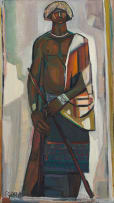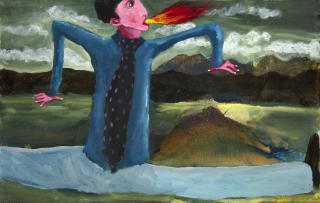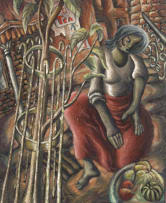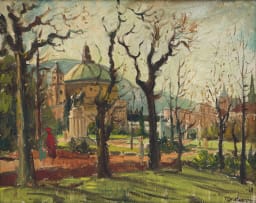Day Sale: Modern and Contemporary Art
Timed Online Auction, 28 August - 18 September 2023
Modern and Contemporary Art with a focus on Cape Moments
About this Item
signed; inscribed with the artist's name and the title on a Pretoria Art Museum label adhered to the reverse
Notes
An interview with Wendy Goldblatt
How did you find yourselves in Spain?
I came over from England at age twenty, very ambitiously, on a boat all on my own. I just wanted to see something of the world and my parents said I could go to my aunt in South Africa. I met Sidney when he had just come back from the Anglo-French art school in London. Before this, he had worked in business for a few years, which he loathed, but he kept saving money until he could afford to study art. Eventually, he saved up enough to go study in England. It was a little art school but very good; it was what he needed. I met him after about eight or nine months. He was already teaching after having come back to South Africa. Somebody introduced us and we just clicked. He was a lot older than me, but it was wonderful, he was a marvellous man, and we were married after about six months (we did go to Swaziland on our honeymoon, where he painted local people and portraits which showed a lot of strength and promise). Sidney wanted to travel back to Europe, as he had had to come back early because his father was ill; he felt that he hadn't finished what he wanted to do. He had an absolute yearning to go to Spain. I just loved travelling anywhere, so I was just happy to go with. It was a marvellous experience and when I look back, it took courage because we had very little money, but we had decided that's what we wanted to do. We decided that we would save for a year and then we went to Spain in 1957, two years after we were married. We went by boat to England and stayed with my father in London before we went to Spain. We didn't really know where we wanted to go, so we bought a little car and set off down the coast of France, arriving in St Sebastian in the North of Spain. We mostly just travelled as we felt like it, our only plan being to end up somewhere in the South of Spain. Slowly we made our way down, staying in Madrid for about two weeks going to all the galleries, which was an absolute treat, and then we went to Cordoba and Seville; it was so beautiful, and Sidney just drew and drew and photographed and drew as we went. We took turns driving and could only really afford to eat once a day, but it was marvellous. We landed up in the south thinking that we would like to stay in Torremolinos, but Marbella was where we ended up - which was completely undiscovered then. It was wonderful, every day we went down to the beach and Sidney would go paint. The only problem was that the locals were very nosey and interested.
Every time he went to paint, they came from far and wide, gathering around him saying 'vira! le artiste!' (look at the artist!). So he started going at seven in the morning and doing his painting, then coming home at about eleven. There was a wonderful port, hence lots of paintings of fishermen. Douglas Portway came to visit us there on his way to Ibiza. It was all very exciting. Sidney loved the landscape, he loved the bullfights, I didn't, but for him it was all about the movement and the colour and excitement. We wanted to stay, but we also wanted to have children, and there were no schools, so we decided to come back. Sidney always had a call for Africa. He loved Africa, the colour, the people, the whole atmosphere. So, after four months of being there - we had already been away for six months - we travelled slowly back up the other Spanish coast, through the south of France, into Switzerland and Italy for three months. We didn't stop anywhere for long, not living anywhere, but he did a lot of sketching on the way and we came home after spending the winter in London where Sidney rented a little studio. We were away for a year altogether and then we came back to our little flat in Hillbrow.
What would you say was his greatest source of inspiration during that time?
I think it was the general scenery. The colours of Spain. That blue was so beautiful, very intense, and the houses were mostly white in those days, probably not now. And the roofs, the lovely roofs, which were all red. When he came back, he started doing linocuts and he did a couple linocuts of Torremolinos, the roofs and so on. He carried on doing linocuts until the end.
Was there a distinct 'Spanish' style?
I suppose [his style] was relatively impressionistic, but free. You can see he would not be hard bound by anything. If he felt like doing an abstract painting, he would do it. And if people said to him, 'you don't usually do that', he would say, 'but that's what I felt like painting', and that is how he was. He wanted freedom as an artist. He was a free spirit, not tied down. He was adamant about that. People used to criticise him for that but he didn't care, that's what he wanted to paint. Freedom of creation, whereas by rote, no, definitely not.
How were the Spanish works received coming back to South Africa?
The first exhibition of his Spanish work was at Lidchi Gallery after we came home and he virtually sold out that exhibition. Then he was invited to the Venice Biennale in 1961 or 62, and whoever did the crit picked out Sidney's paintings from the Venice Biennale and said that 'they sang from the canvas', which was lovely. That was very gratifying. He wasn't interested in selling paintings overseas; he said it wasn't worth dragging them around. But he loved Cape Town and did very well in Cape Town. He had a number of exhibitions and he's in all the National Galleries.
Do you think the Spanish influence carried over into his other work?
Oh yes, I think it carried over into everything. It was just the colour and his whole conception of what he liked to paint. For instance, he loved Namibia, the colours there, the different architecture and the animals. His style before Spain was very different. They didn't have the colour of Spain; it was after Spain that everything burst into colour.
Exhibited
Pretoria Art Museum, Sidney Goldblatt: Retrospective Exhibition, 1981, illustrated in the exhibition catalogue on page 3.










